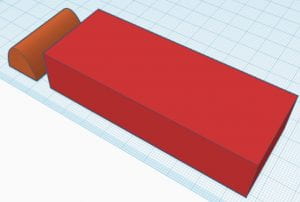Hello everyone, and welcome back to another reflection on our most recent project. In this project, we were supposed to use tinkercad.com to create a 3D model of a real life object and maximize it for surface area or volume. Here we go!
To start, we paired in groups up to three. My group was Theryn, Noah, and Myself. We decided to do a RC Motor. Theryn made the motor part of the motor, Noah made the heat sync, and I made the battery. As you may be able to tell, I had the most simple part of the motor. In reality, the battery is pretty complicated, but when you’re making it in a 3D modelling system, its pretty simple. The project criteria required ten basic 3D shapes, and my original draft did not have ten. My first draft looked like this.
Broken down, it looked like this
Yeah… not ten shapes. More like 2. This model did not include wires that were part of most batteries. And since I need 8 more shapes, I decided to add wires. This added 2 cylinders, and 14 smaller cylinders. Here are what it looks like now.
This would be my final model that I submitted for 3D printing.
Now, while the more important part of the project may seem to be the 3D printing, it was actually calculating the surface area and volume that took the most time. For mine, I had to calculate the surface area and volume of cylinders, one rectangular prism, and one half elliptical cylinder. We also had to calculate the surface area to volume ratio. All of my calculations are here.
Reasoning and Analyzing: Model mathematics in contextualized experiences
To get accomplished on this skill, we had to design a 3D object using TinkerCad or other design software. The design is optimized for either maximum volume or maximum surface area. The design should include at least 10 basic 3D shapes. My battery did this, and I think I did pretty well on this because I calculated the surface area and volume of a half elliptical cylinder.
Communicating and Representing: Explain and justify mathematical ideas and decisions
For this competency we had to measure, calculate, and compared surface area and volume are for efficiency. These factors are explained in detail in a keynote presentation to the class. I think I did this pretty well, and I think that my presentation explained my project to a full extent.
Applying and innovating: Contribute to care for self, others, community, and world through personal or collaborative approaches.
For this, all of our class time must be used efficiently for learning without distractions. I think I did this pretty well and maintained focus during class. I think a lot of this was due to me enjoying modelling in tinkercad.
Thank you all very much for listening to my ramble, and I will see you next reflection.





Leave a Reply